Related Research Articles

The Bristol Proteus was the Bristol Engine Company's first mass-produced gas turbine engine design, a turboprop that delivered just over 4,000 hp (3,000 kW). The Proteus was a reverse-flow gas turbine. Because the second turbine drove no compressor stages, but only the propeller, this engine was classified as a free-turbine. It powered the Bristol Britannia airliner, small naval patrol craft, hovercraft and electrical generating sets. It was also used to power a land-speed record car, the Bluebird-Proteus CN7. After the merger of Bristol with Armstrong Siddeley the engine became the Bristol Siddeley Proteus, and later the Rolls-Royce Proteus. The Proteus was to have been superseded by the Bristol Orion which would have given a Britannia a 75% increase in power for cruising faster.

The Handley Page W.8, W.9 and W.10 were British two- and three-engine medium-range biplane airliners designed and built by Handley Page.

The de Havilland DH.50 was a 1920s British large single-engined biplane transport built by de Havilland at Stag Lane Aerodrome, Edgware, and licence-built in Australia, Belgium, and Czechoslovakia.
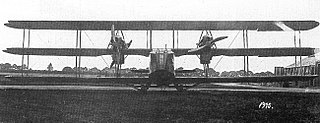
The Bristol Braemar was a British heavy bomber aircraft developed at the end of the First World War for the Royal Air Force. Only two prototypes were constructed.

The Bristol Pullman was a British prototype passenger aircraft developed from the Braemar triplane heavy bomber.

The Airco DH.11 Oxford was a British twin-engined biplane bomber which was designed to replace the earlier Airco DH.10 Amiens. It was designed to use the unsuccessful ABC Dragonfly engine and was abandoned after the first prototype was built.

The Avro Type 584 Avocet was a British single-engined naval fighter prototype, designed and built by Avro. While the Avocet was not built in numbers, one of the prototypes was used as a seaplane trainer for the Royal Air Force's (RAF) High Speed Flight.
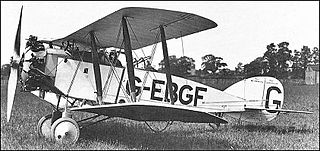
The Bristol Type 76 Jupiter Fighter and Type 89 Trainer were derivatives of the British fighter of the First World War, powered by Bristol Jupiter radial engines. While unsuccessful as a fighter, it was used as an advanced trainer aircraft between 1924 and 1933.

The DFW R.II was a German bomber aircraft of World War I. It was developed at a request by the Luftstreitkräfte in spring 1917 after their experience with the R.I had been generally positive, but only two were ever built despite six being ordered.

The Supermarine Sea King was a British single-seat amphibious biplane fighter designed by Supermarine in 1919. Developed from the Supermarine Baby and the Supermarine Sea Lion I, the Sea King was a single seater biplane powered by a pusher 160 horsepower (120 kW) Beardmore engine. It first flew in early 1920 and was exhibited by Supermarine at the 1920 Olympia Show in London. The company released drawings of the aircraft's design prior to the show; what it exhibited was probably a modified Supermarine Baby.
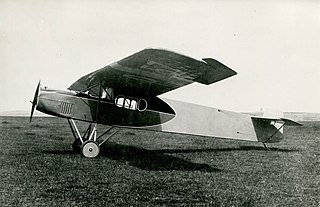
The Fokker F.II was the first of a long series of commercial aircraft from the Fokker Aircraft Company, flying in 1919. In a biplane age, it presented a distinct clean, high-wing monoplane style that sold successfully across Europe and North America during the development of commercial passenger-carrying aviation.
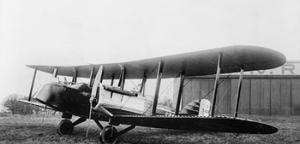
The Avro 533 Manchester was a First World War-era twin-engine biplane photo-reconnaissance and bomber aircraft designed and manufactured by Avro.

The Bristol Seely was entered into an Air Ministry competition for safe civil aeroplanes held in 1920. It was a single-engine biplane with accommodation for one passenger. After the competition, the single Seely was used as a testbed for the Bristol Jupiter engine development programme.
The Boulton & Paul P.12 Bodmin was an experimental British twin-engined biplane bomber with its engines mounted in a fuselage engine room and with tandem pairs of tractor and pusher airscrews mounted between the wings. The two Bodmins built flew in 1924, proving the concept but the layout was not developed to production.
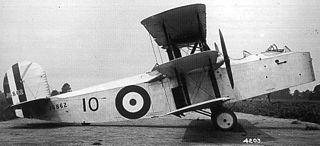
The Parnall Possum was an experimental triplane with a single, central engine driving wing-mounted propellers via shafts and gears. Two of these British aircraft were built in the mid-1920s.

The Wanamaker Triplane or Curtiss Model T, retroactively renamed Curtiss Model 3 was a large experimental four-engined triplane patrol flying boat of World War I. It was the first four-engined aircraft built in the United States. Only a single example (No.3073) was completed. At the time, the Triplane was the largest seaplane in the world.
The Sopwith Cobham was a British twin-engined triplane bomber aircraft designed and built by the Sopwith Aviation Company during the First World War. The only twin-engined aircraft built by Sopwith, the Cobham did not fly until after the end of the war, and was unsuccessful due to the failure of its engines, only three prototypes being built.

The Besson H-3 was a French civil touring triplane flying boat designed by the Marcel Besson company of Boulogne. One aircraft was built and the type did not enter production.
The Bristol-Burney seaplanes were a pair of experimental seaplanes produced by a collaboration between Lt. Dennistoun Burney and the British and Colonial Aeroplane Company during 1912–14. The aircraft, neither of which was successfully flown, featured a novel hydroplane undercarriage. Although not a success, their development was the basis of Burney's later invention of the paravane.
The Morane-Saulnier TRK was a prototype French bomber built during World War I.